Nursing Assignment: Post-Operative Care Decision Making Analysis
VerifiedAdded on 2022/12/19
|16
|4761
|82
Report
AI Summary
This nursing assignment delves into the complexities of post-operative care, focusing on a case study involving a 68-year-old patient, Masthan, who underwent a laparoscopic cholecystectomy. The report analyzes the clinical decision-making process, ethical considerations, and the application of nursing frameworks, specifically the Hellreigel, Jackson, and Slocum framework. It explores the challenges nurses face, including factors influencing decision-making such as patient age, knowledge, and environmental factors. The assignment emphasizes the importance of evidence-based practice, the SOFA score, and deductive reasoning in assessing and managing post-operative complications, including the potential for sepsis. It critically examines the decisions made, justifies them based on evidence, and reflects on the learning outcomes. The report highlights the significance of comprehensive nursing assessments, care planning, and the crucial role of family support in patient recovery, all while adhering to ethical guidelines and professional standards. It also discusses the impact of constraints on effective decision-making and the benefits of teamwork in providing quality patient care. The assignment provides a detailed overview of the patient's condition, the interventions implemented, and the rationale behind them, ultimately contributing to the understanding of effective nursing practices in post-operative care.
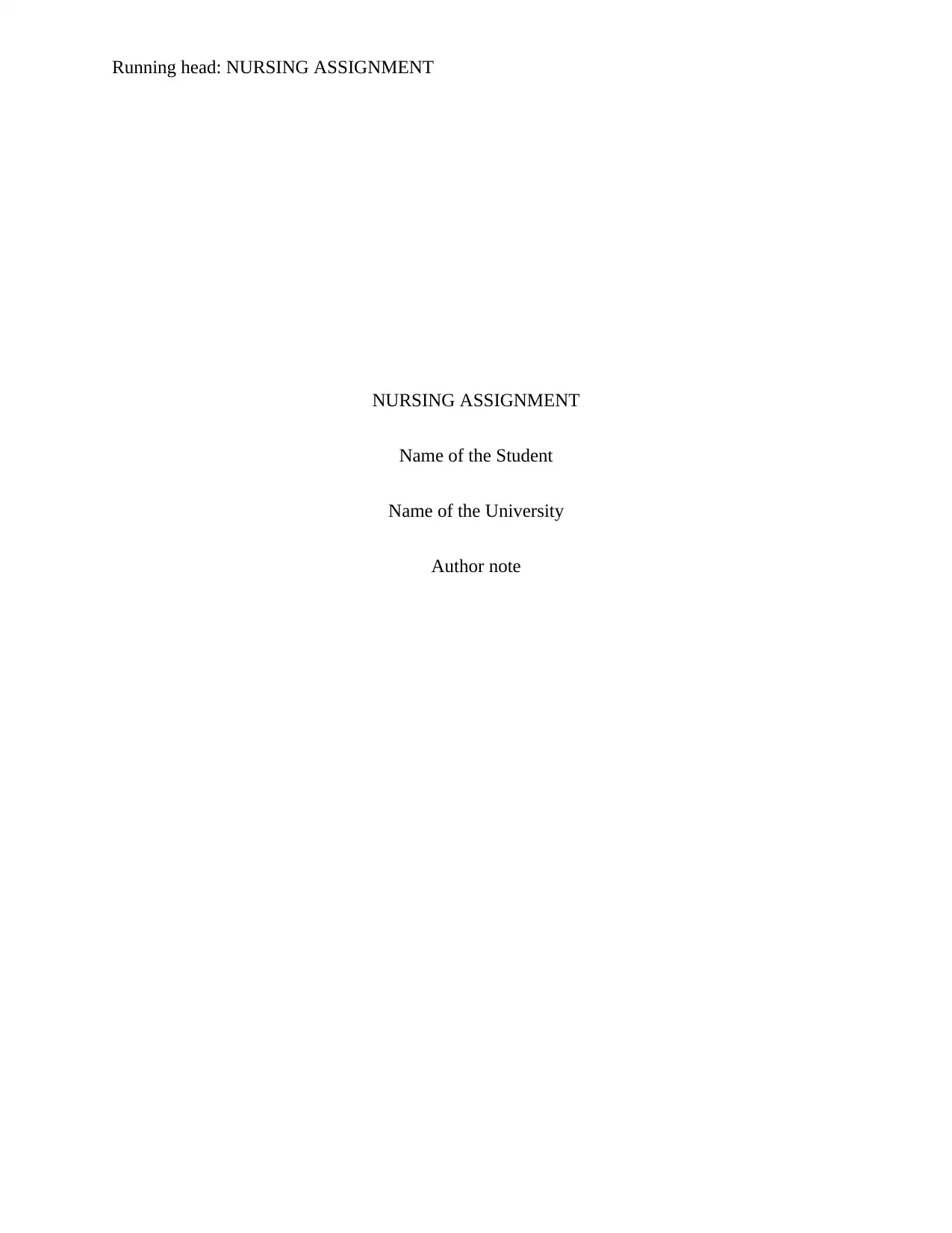
Running head: NURSING ASSIGNMENT
NURSING ASSIGNMENT
Name of the Student
Name of the University
Author note
NURSING ASSIGNMENT
Name of the Student
Name of the University
Author note
Paraphrase This Document
Need a fresh take? Get an instant paraphrase of this document with our AI Paraphraser
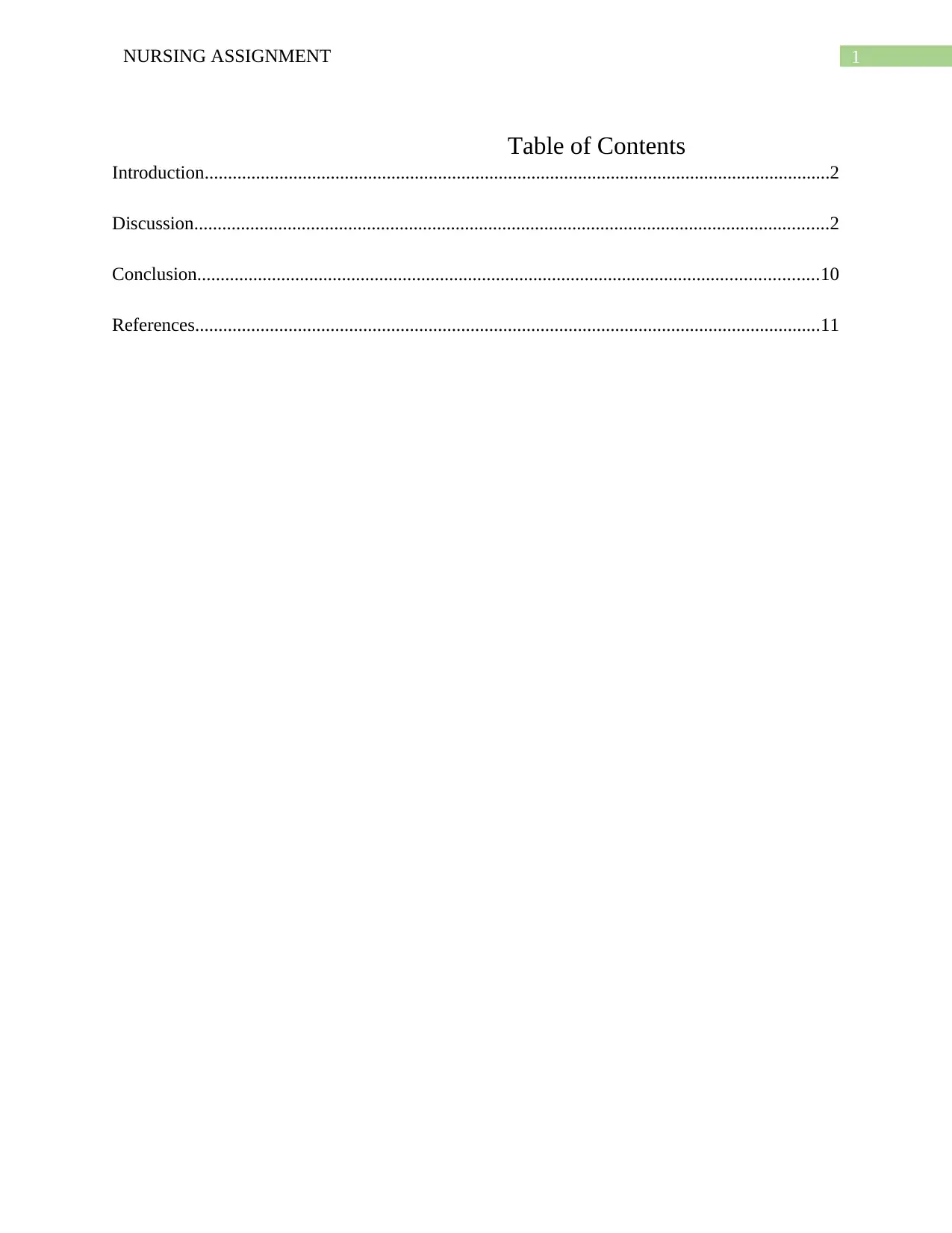
1NURSING ASSIGNMENT
Table of Contents
Introduction......................................................................................................................................2
Discussion........................................................................................................................................2
Conclusion.....................................................................................................................................10
References......................................................................................................................................11
Table of Contents
Introduction......................................................................................................................................2
Discussion........................................................................................................................................2
Conclusion.....................................................................................................................................10
References......................................................................................................................................11
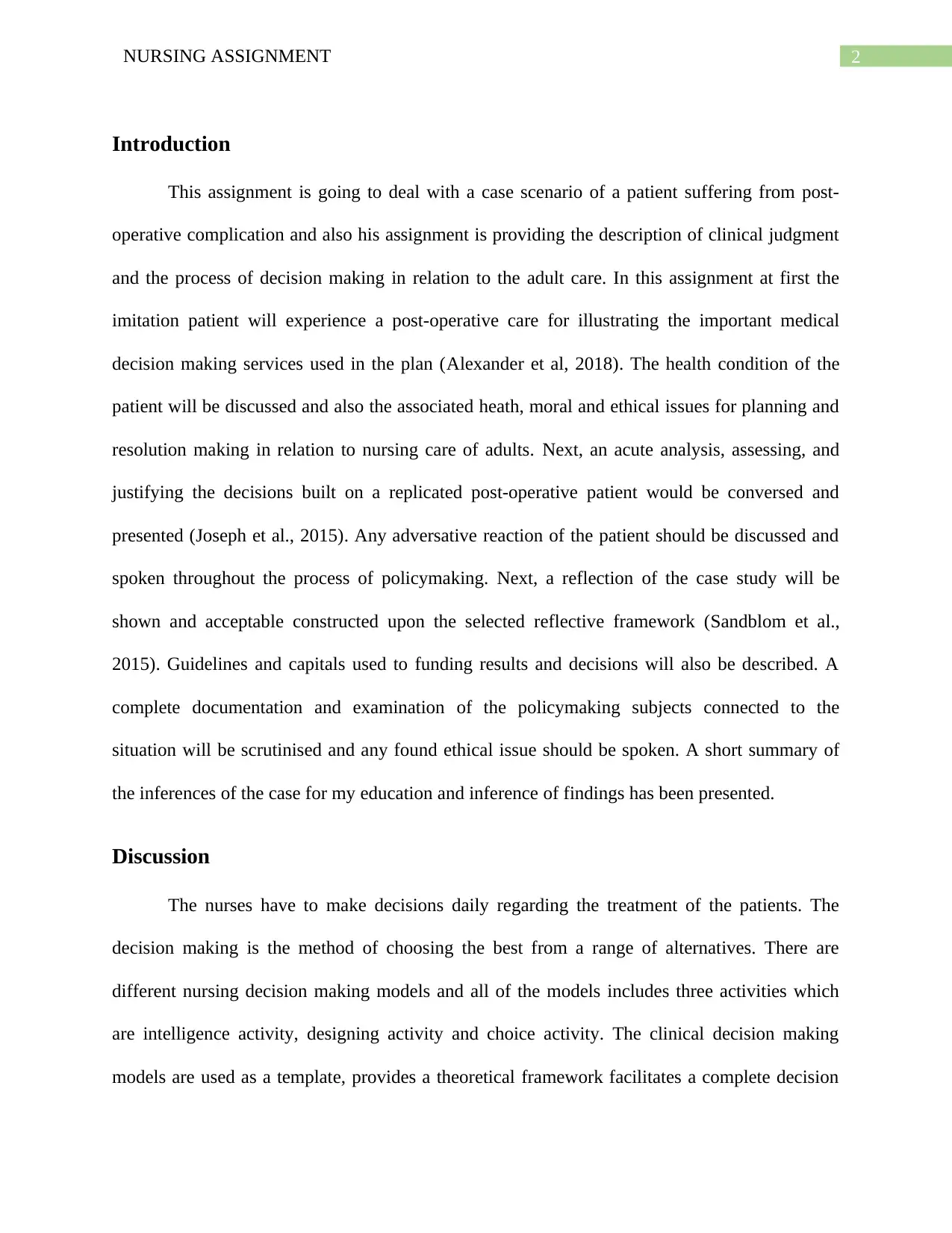
2NURSING ASSIGNMENT
Introduction
This assignment is going to deal with a case scenario of a patient suffering from post-
operative complication and also his assignment is providing the description of clinical judgment
and the process of decision making in relation to the adult care. In this assignment at first the
imitation patient will experience a post-operative care for illustrating the important medical
decision making services used in the plan (Alexander et al, 2018). The health condition of the
patient will be discussed and also the associated heath, moral and ethical issues for planning and
resolution making in relation to nursing care of adults. Next, an acute analysis, assessing, and
justifying the decisions built on a replicated post-operative patient would be conversed and
presented (Joseph et al., 2015). Any adversative reaction of the patient should be discussed and
spoken throughout the process of policymaking. Next, a reflection of the case study will be
shown and acceptable constructed upon the selected reflective framework (Sandblom et al.,
2015). Guidelines and capitals used to funding results and decisions will also be described. A
complete documentation and examination of the policymaking subjects connected to the
situation will be scrutinised and any found ethical issue should be spoken. A short summary of
the inferences of the case for my education and inference of findings has been presented.
Discussion
The nurses have to make decisions daily regarding the treatment of the patients. The
decision making is the method of choosing the best from a range of alternatives. There are
different nursing decision making models and all of the models includes three activities which
are intelligence activity, designing activity and choice activity. The clinical decision making
models are used as a template, provides a theoretical framework facilitates a complete decision
Introduction
This assignment is going to deal with a case scenario of a patient suffering from post-
operative complication and also his assignment is providing the description of clinical judgment
and the process of decision making in relation to the adult care. In this assignment at first the
imitation patient will experience a post-operative care for illustrating the important medical
decision making services used in the plan (Alexander et al, 2018). The health condition of the
patient will be discussed and also the associated heath, moral and ethical issues for planning and
resolution making in relation to nursing care of adults. Next, an acute analysis, assessing, and
justifying the decisions built on a replicated post-operative patient would be conversed and
presented (Joseph et al., 2015). Any adversative reaction of the patient should be discussed and
spoken throughout the process of policymaking. Next, a reflection of the case study will be
shown and acceptable constructed upon the selected reflective framework (Sandblom et al.,
2015). Guidelines and capitals used to funding results and decisions will also be described. A
complete documentation and examination of the policymaking subjects connected to the
situation will be scrutinised and any found ethical issue should be spoken. A short summary of
the inferences of the case for my education and inference of findings has been presented.
Discussion
The nurses have to make decisions daily regarding the treatment of the patients. The
decision making is the method of choosing the best from a range of alternatives. There are
different nursing decision making models and all of the models includes three activities which
are intelligence activity, designing activity and choice activity. The clinical decision making
models are used as a template, provides a theoretical framework facilitates a complete decision
⊘ This is a preview!⊘
Do you want full access?
Subscribe today to unlock all pages.

Trusted by 1+ million students worldwide

3NURSING ASSIGNMENT
making and test the reliability and validity of the decisions. Few of the decision making models
of nursing are the Information – Processing Model, Humanistic Intuitive Model and cognitive
continuum model. A nurse will be able to effectively take any decision if any of the nursing
procedures are followed, however certain factors are there which disturb the process of decision
making. The factors which impact the decision making procedures of the nurses are the age and
the educational level of the patients, the knowledge, experience and the proper recognition of
cues of the diseases. The comparison of the specific hypothesis and the broad hypothesis also
affect the process of decision making. The emotions and the perceptions of the patients and
communication with the peers are another factors affecting the clinical decisions with the
patients. The environment where the patient is residing is another important factor which have
negative impact on the decision making methods of the patient. The nurses have to take effective
decisions in the circumstances where there are inadequate sources, issues regarding the
cooperation of the patients and the family members in treating the patient. The nurses have to
take effective decisions if they think that the values, beliefs and attitudes of the patients are
different from those of the nurses.
The post-operative complication is one of the important aspect of the nursing practices.
The nurses are responsible for providing comprehensive care to the patients starting from the
admission of the patient till the discharge of the patients (Ruangsin et al., 2015). The nurses must
learn several nursing practices regarding the post-operative complications during their nursing g
study days only so that they can take care the cases of the post-operative complications
efficiently. It is very necessary fir the nurses to know about the several infection control
strategies so that they can prevent the spread of infections after the operation of the patient. The
complications of the post operation vary from person to person according the severity of the
making and test the reliability and validity of the decisions. Few of the decision making models
of nursing are the Information – Processing Model, Humanistic Intuitive Model and cognitive
continuum model. A nurse will be able to effectively take any decision if any of the nursing
procedures are followed, however certain factors are there which disturb the process of decision
making. The factors which impact the decision making procedures of the nurses are the age and
the educational level of the patients, the knowledge, experience and the proper recognition of
cues of the diseases. The comparison of the specific hypothesis and the broad hypothesis also
affect the process of decision making. The emotions and the perceptions of the patients and
communication with the peers are another factors affecting the clinical decisions with the
patients. The environment where the patient is residing is another important factor which have
negative impact on the decision making methods of the patient. The nurses have to take effective
decisions in the circumstances where there are inadequate sources, issues regarding the
cooperation of the patients and the family members in treating the patient. The nurses have to
take effective decisions if they think that the values, beliefs and attitudes of the patients are
different from those of the nurses.
The post-operative complication is one of the important aspect of the nursing practices.
The nurses are responsible for providing comprehensive care to the patients starting from the
admission of the patient till the discharge of the patients (Ruangsin et al., 2015). The nurses must
learn several nursing practices regarding the post-operative complications during their nursing g
study days only so that they can take care the cases of the post-operative complications
efficiently. It is very necessary fir the nurses to know about the several infection control
strategies so that they can prevent the spread of infections after the operation of the patient. The
complications of the post operation vary from person to person according the severity of the
Paraphrase This Document
Need a fresh take? Get an instant paraphrase of this document with our AI Paraphraser
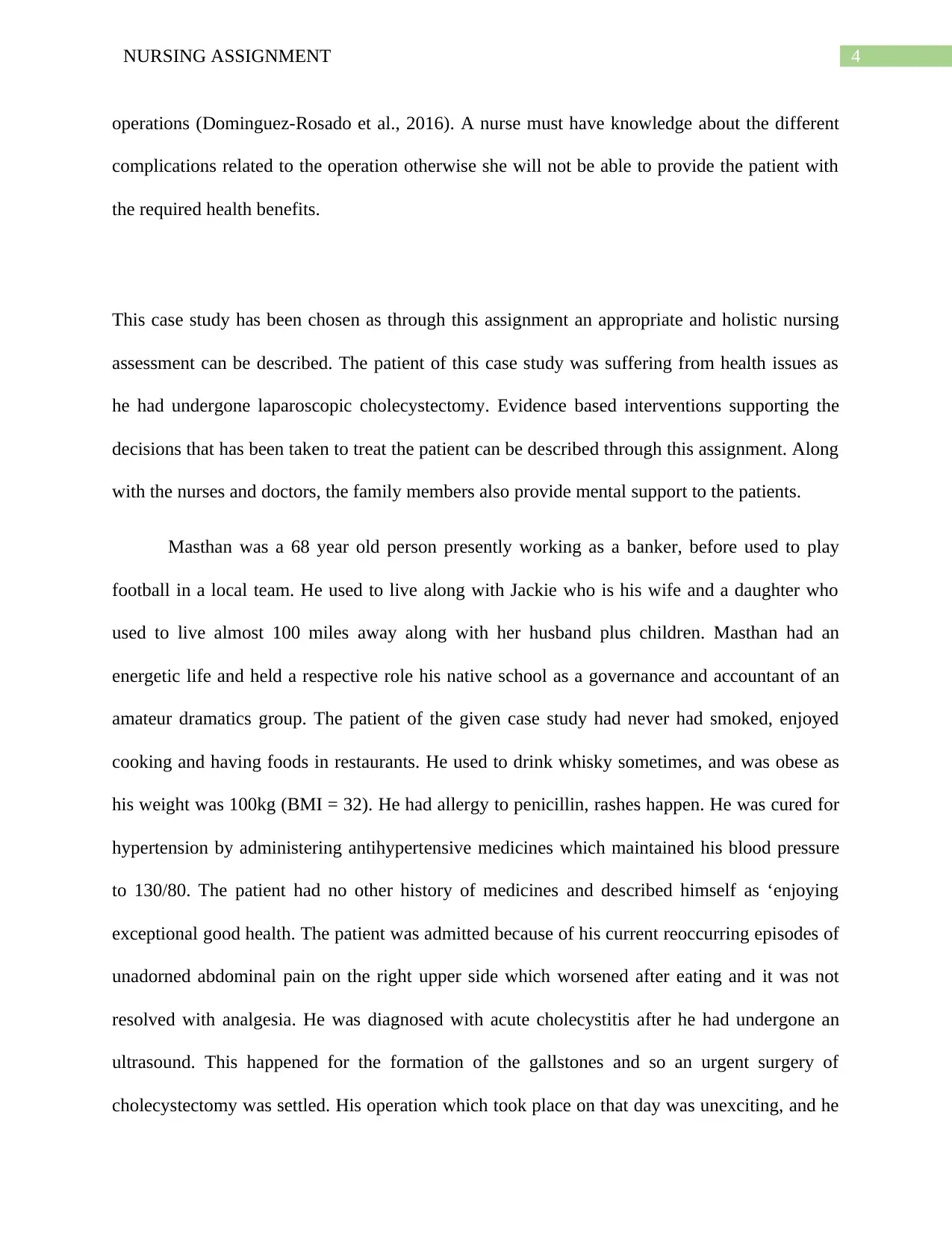
4NURSING ASSIGNMENT
operations (Dominguez-Rosado et al., 2016). A nurse must have knowledge about the different
complications related to the operation otherwise she will not be able to provide the patient with
the required health benefits.
This case study has been chosen as through this assignment an appropriate and holistic nursing
assessment can be described. The patient of this case study was suffering from health issues as
he had undergone laparoscopic cholecystectomy. Evidence based interventions supporting the
decisions that has been taken to treat the patient can be described through this assignment. Along
with the nurses and doctors, the family members also provide mental support to the patients.
Masthan was a 68 year old person presently working as a banker, before used to play
football in a local team. He used to live along with Jackie who is his wife and a daughter who
used to live almost 100 miles away along with her husband plus children. Masthan had an
energetic life and held a respective role his native school as a governance and accountant of an
amateur dramatics group. The patient of the given case study had never had smoked, enjoyed
cooking and having foods in restaurants. He used to drink whisky sometimes, and was obese as
his weight was 100kg (BMI = 32). He had allergy to penicillin, rashes happen. He was cured for
hypertension by administering antihypertensive medicines which maintained his blood pressure
to 130/80. The patient had no other history of medicines and described himself as ‘enjoying
exceptional good health. The patient was admitted because of his current reoccurring episodes of
unadorned abdominal pain on the right upper side which worsened after eating and it was not
resolved with analgesia. He was diagnosed with acute cholecystitis after he had undergone an
ultrasound. This happened for the formation of the gallstones and so an urgent surgery of
cholecystectomy was settled. His operation which took place on that day was unexciting, and he
operations (Dominguez-Rosado et al., 2016). A nurse must have knowledge about the different
complications related to the operation otherwise she will not be able to provide the patient with
the required health benefits.
This case study has been chosen as through this assignment an appropriate and holistic nursing
assessment can be described. The patient of this case study was suffering from health issues as
he had undergone laparoscopic cholecystectomy. Evidence based interventions supporting the
decisions that has been taken to treat the patient can be described through this assignment. Along
with the nurses and doctors, the family members also provide mental support to the patients.
Masthan was a 68 year old person presently working as a banker, before used to play
football in a local team. He used to live along with Jackie who is his wife and a daughter who
used to live almost 100 miles away along with her husband plus children. Masthan had an
energetic life and held a respective role his native school as a governance and accountant of an
amateur dramatics group. The patient of the given case study had never had smoked, enjoyed
cooking and having foods in restaurants. He used to drink whisky sometimes, and was obese as
his weight was 100kg (BMI = 32). He had allergy to penicillin, rashes happen. He was cured for
hypertension by administering antihypertensive medicines which maintained his blood pressure
to 130/80. The patient had no other history of medicines and described himself as ‘enjoying
exceptional good health. The patient was admitted because of his current reoccurring episodes of
unadorned abdominal pain on the right upper side which worsened after eating and it was not
resolved with analgesia. He was diagnosed with acute cholecystitis after he had undergone an
ultrasound. This happened for the formation of the gallstones and so an urgent surgery of
cholecystectomy was settled. His operation which took place on that day was unexciting, and he
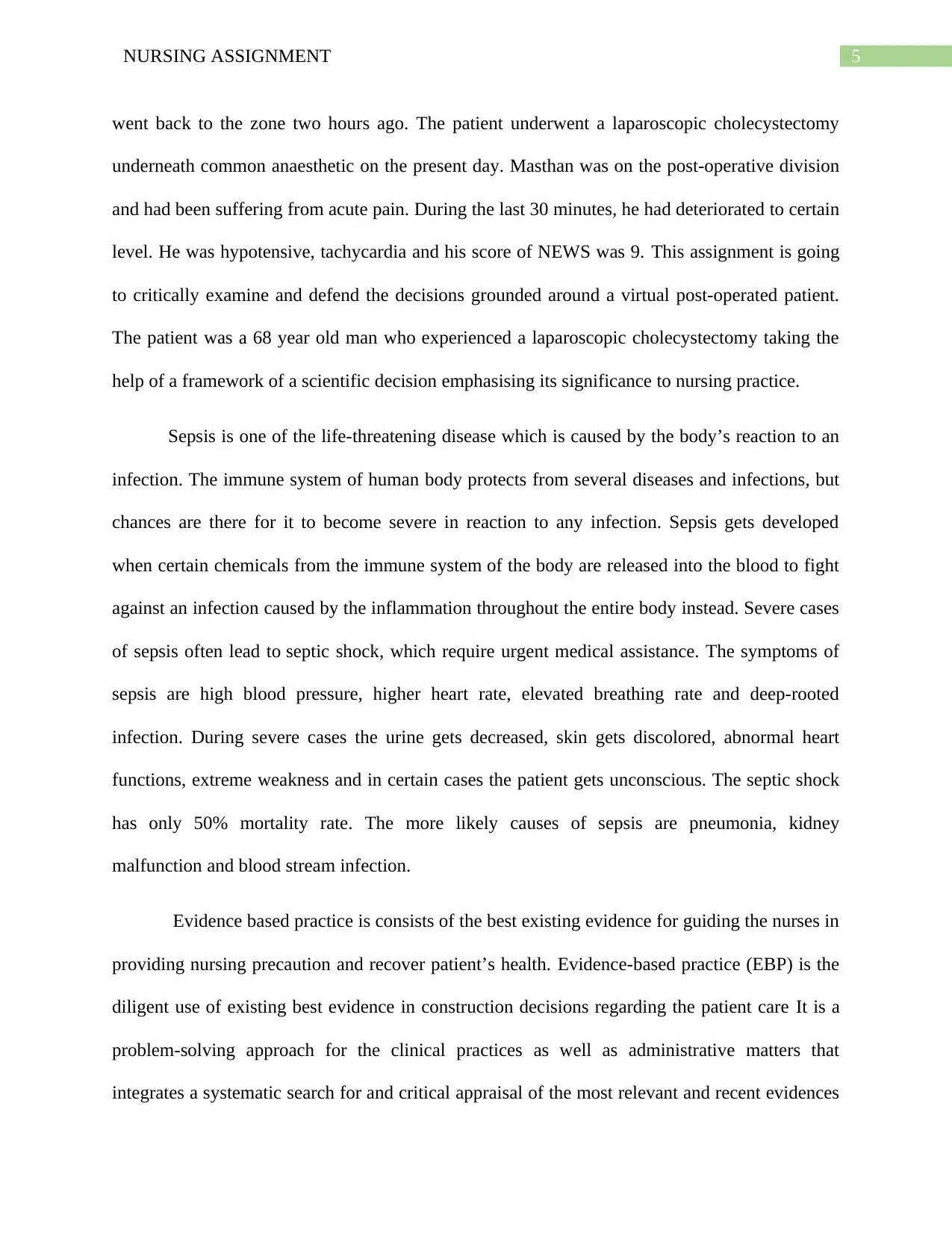
5NURSING ASSIGNMENT
went back to the zone two hours ago. The patient underwent a laparoscopic cholecystectomy
underneath common anaesthetic on the present day. Masthan was on the post-operative division
and had been suffering from acute pain. During the last 30 minutes, he had deteriorated to certain
level. He was hypotensive, tachycardia and his score of NEWS was 9. This assignment is going
to critically examine and defend the decisions grounded around a virtual post-operated patient.
The patient was a 68 year old man who experienced a laparoscopic cholecystectomy taking the
help of a framework of a scientific decision emphasising its significance to nursing practice.
Sepsis is one of the life-threatening disease which is caused by the body’s reaction to an
infection. The immune system of human body protects from several diseases and infections, but
chances are there for it to become severe in reaction to any infection. Sepsis gets developed
when certain chemicals from the immune system of the body are released into the blood to fight
against an infection caused by the inflammation throughout the entire body instead. Severe cases
of sepsis often lead to septic shock, which require urgent medical assistance. The symptoms of
sepsis are high blood pressure, higher heart rate, elevated breathing rate and deep-rooted
infection. During severe cases the urine gets decreased, skin gets discolored, abnormal heart
functions, extreme weakness and in certain cases the patient gets unconscious. The septic shock
has only 50% mortality rate. The more likely causes of sepsis are pneumonia, kidney
malfunction and blood stream infection.
Evidence based practice is consists of the best existing evidence for guiding the nurses in
providing nursing precaution and recover patient’s health. Evidence-based practice (EBP) is the
diligent use of existing best evidence in construction decisions regarding the patient care It is a
problem-solving approach for the clinical practices as well as administrative matters that
integrates a systematic search for and critical appraisal of the most relevant and recent evidences
went back to the zone two hours ago. The patient underwent a laparoscopic cholecystectomy
underneath common anaesthetic on the present day. Masthan was on the post-operative division
and had been suffering from acute pain. During the last 30 minutes, he had deteriorated to certain
level. He was hypotensive, tachycardia and his score of NEWS was 9. This assignment is going
to critically examine and defend the decisions grounded around a virtual post-operated patient.
The patient was a 68 year old man who experienced a laparoscopic cholecystectomy taking the
help of a framework of a scientific decision emphasising its significance to nursing practice.
Sepsis is one of the life-threatening disease which is caused by the body’s reaction to an
infection. The immune system of human body protects from several diseases and infections, but
chances are there for it to become severe in reaction to any infection. Sepsis gets developed
when certain chemicals from the immune system of the body are released into the blood to fight
against an infection caused by the inflammation throughout the entire body instead. Severe cases
of sepsis often lead to septic shock, which require urgent medical assistance. The symptoms of
sepsis are high blood pressure, higher heart rate, elevated breathing rate and deep-rooted
infection. During severe cases the urine gets decreased, skin gets discolored, abnormal heart
functions, extreme weakness and in certain cases the patient gets unconscious. The septic shock
has only 50% mortality rate. The more likely causes of sepsis are pneumonia, kidney
malfunction and blood stream infection.
Evidence based practice is consists of the best existing evidence for guiding the nurses in
providing nursing precaution and recover patient’s health. Evidence-based practice (EBP) is the
diligent use of existing best evidence in construction decisions regarding the patient care It is a
problem-solving approach for the clinical practices as well as administrative matters that
integrates a systematic search for and critical appraisal of the most relevant and recent evidences
⊘ This is a preview!⊘
Do you want full access?
Subscribe today to unlock all pages.

Trusted by 1+ million students worldwide
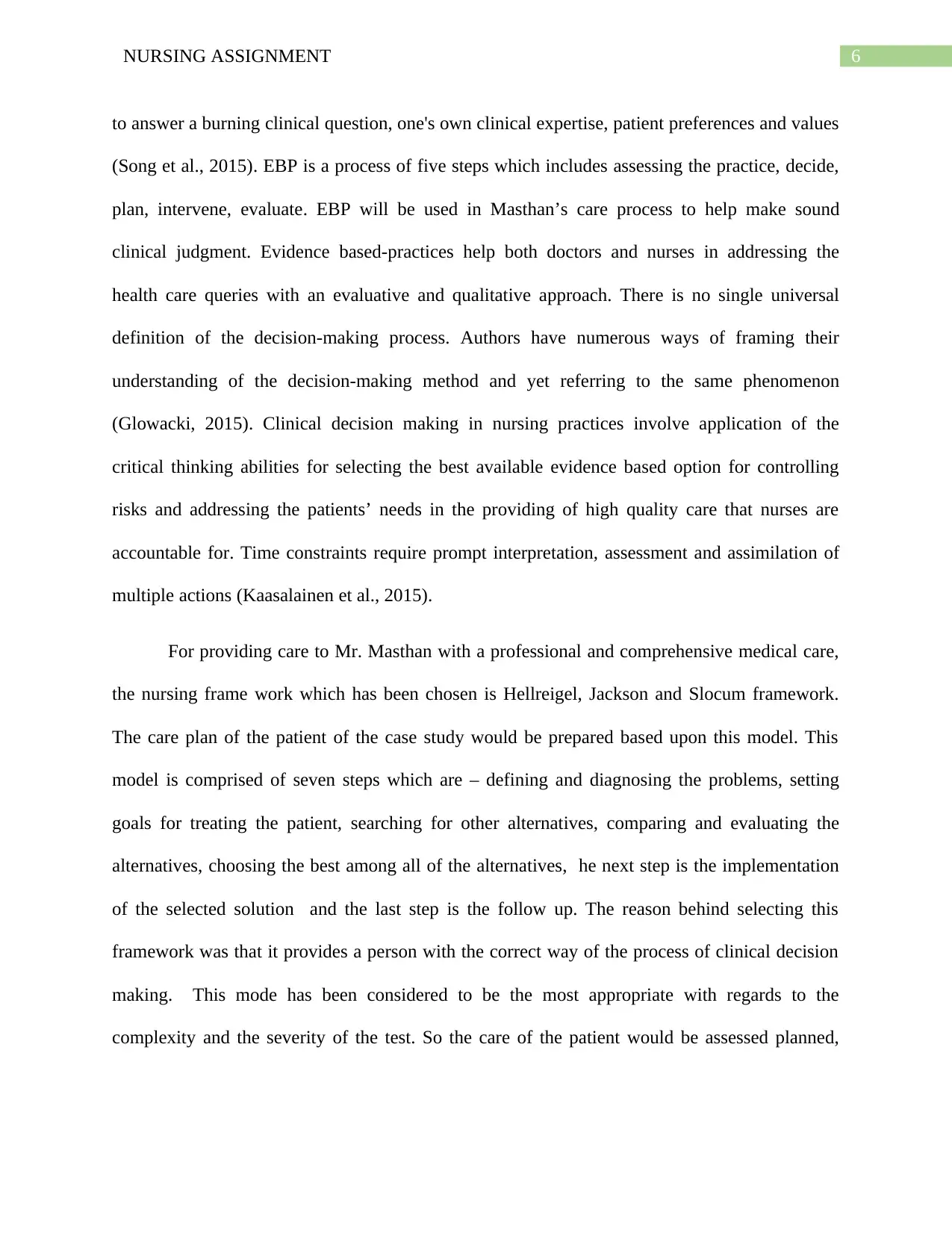
6NURSING ASSIGNMENT
to answer a burning clinical question, one's own clinical expertise, patient preferences and values
(Song et al., 2015). EBP is a process of five steps which includes assessing the practice, decide,
plan, intervene, evaluate. EBP will be used in Masthan’s care process to help make sound
clinical judgment. Evidence based-practices help both doctors and nurses in addressing the
health care queries with an evaluative and qualitative approach. There is no single universal
definition of the decision-making process. Authors have numerous ways of framing their
understanding of the decision-making method and yet referring to the same phenomenon
(Glowacki, 2015). Clinical decision making in nursing practices involve application of the
critical thinking abilities for selecting the best available evidence based option for controlling
risks and addressing the patients’ needs in the providing of high quality care that nurses are
accountable for. Time constraints require prompt interpretation, assessment and assimilation of
multiple actions (Kaasalainen et al., 2015).
For providing care to Mr. Masthan with a professional and comprehensive medical care,
the nursing frame work which has been chosen is Hellreigel, Jackson and Slocum framework.
The care plan of the patient of the case study would be prepared based upon this model. This
model is comprised of seven steps which are – defining and diagnosing the problems, setting
goals for treating the patient, searching for other alternatives, comparing and evaluating the
alternatives, choosing the best among all of the alternatives, he next step is the implementation
of the selected solution and the last step is the follow up. The reason behind selecting this
framework was that it provides a person with the correct way of the process of clinical decision
making. This mode has been considered to be the most appropriate with regards to the
complexity and the severity of the test. So the care of the patient would be assessed planned,
to answer a burning clinical question, one's own clinical expertise, patient preferences and values
(Song et al., 2015). EBP is a process of five steps which includes assessing the practice, decide,
plan, intervene, evaluate. EBP will be used in Masthan’s care process to help make sound
clinical judgment. Evidence based-practices help both doctors and nurses in addressing the
health care queries with an evaluative and qualitative approach. There is no single universal
definition of the decision-making process. Authors have numerous ways of framing their
understanding of the decision-making method and yet referring to the same phenomenon
(Glowacki, 2015). Clinical decision making in nursing practices involve application of the
critical thinking abilities for selecting the best available evidence based option for controlling
risks and addressing the patients’ needs in the providing of high quality care that nurses are
accountable for. Time constraints require prompt interpretation, assessment and assimilation of
multiple actions (Kaasalainen et al., 2015).
For providing care to Mr. Masthan with a professional and comprehensive medical care,
the nursing frame work which has been chosen is Hellreigel, Jackson and Slocum framework.
The care plan of the patient of the case study would be prepared based upon this model. This
model is comprised of seven steps which are – defining and diagnosing the problems, setting
goals for treating the patient, searching for other alternatives, comparing and evaluating the
alternatives, choosing the best among all of the alternatives, he next step is the implementation
of the selected solution and the last step is the follow up. The reason behind selecting this
framework was that it provides a person with the correct way of the process of clinical decision
making. This mode has been considered to be the most appropriate with regards to the
complexity and the severity of the test. So the care of the patient would be assessed planned,
Paraphrase This Document
Need a fresh take? Get an instant paraphrase of this document with our AI Paraphraser
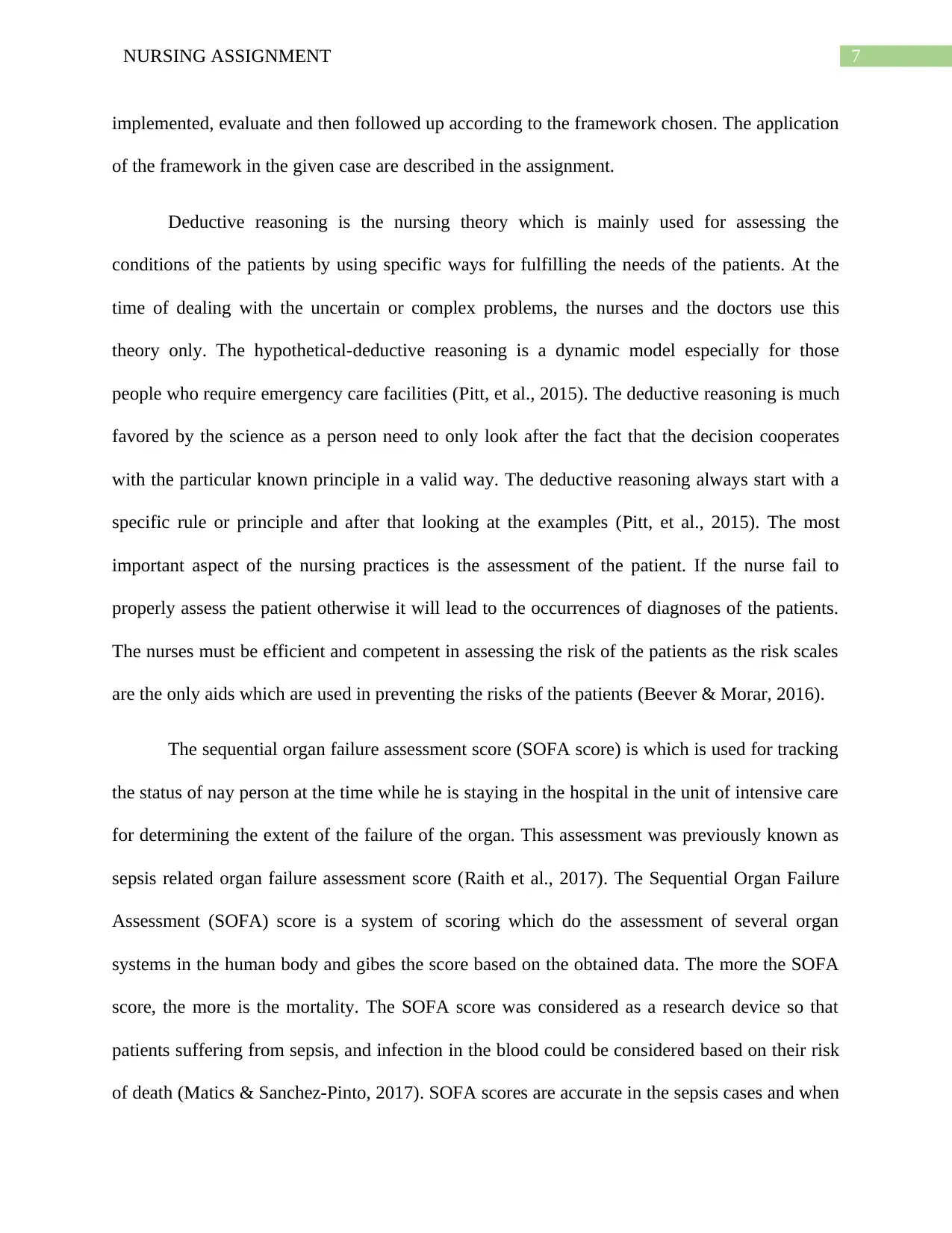
7NURSING ASSIGNMENT
implemented, evaluate and then followed up according to the framework chosen. The application
of the framework in the given case are described in the assignment.
Deductive reasoning is the nursing theory which is mainly used for assessing the
conditions of the patients by using specific ways for fulfilling the needs of the patients. At the
time of dealing with the uncertain or complex problems, the nurses and the doctors use this
theory only. The hypothetical-deductive reasoning is a dynamic model especially for those
people who require emergency care facilities (Pitt, et al., 2015). The deductive reasoning is much
favored by the science as a person need to only look after the fact that the decision cooperates
with the particular known principle in a valid way. The deductive reasoning always start with a
specific rule or principle and after that looking at the examples (Pitt, et al., 2015). The most
important aspect of the nursing practices is the assessment of the patient. If the nurse fail to
properly assess the patient otherwise it will lead to the occurrences of diagnoses of the patients.
The nurses must be efficient and competent in assessing the risk of the patients as the risk scales
are the only aids which are used in preventing the risks of the patients (Beever & Morar, 2016).
The sequential organ failure assessment score (SOFA score) is which is used for tracking
the status of nay person at the time while he is staying in the hospital in the unit of intensive care
for determining the extent of the failure of the organ. This assessment was previously known as
sepsis related organ failure assessment score (Raith et al., 2017). The Sequential Organ Failure
Assessment (SOFA) score is a system of scoring which do the assessment of several organ
systems in the human body and gibes the score based on the obtained data. The more the SOFA
score, the more is the mortality. The SOFA score was considered as a research device so that
patients suffering from sepsis, and infection in the blood could be considered based on their risk
of death (Matics & Sanchez-Pinto, 2017). SOFA scores are accurate in the sepsis cases and when
implemented, evaluate and then followed up according to the framework chosen. The application
of the framework in the given case are described in the assignment.
Deductive reasoning is the nursing theory which is mainly used for assessing the
conditions of the patients by using specific ways for fulfilling the needs of the patients. At the
time of dealing with the uncertain or complex problems, the nurses and the doctors use this
theory only. The hypothetical-deductive reasoning is a dynamic model especially for those
people who require emergency care facilities (Pitt, et al., 2015). The deductive reasoning is much
favored by the science as a person need to only look after the fact that the decision cooperates
with the particular known principle in a valid way. The deductive reasoning always start with a
specific rule or principle and after that looking at the examples (Pitt, et al., 2015). The most
important aspect of the nursing practices is the assessment of the patient. If the nurse fail to
properly assess the patient otherwise it will lead to the occurrences of diagnoses of the patients.
The nurses must be efficient and competent in assessing the risk of the patients as the risk scales
are the only aids which are used in preventing the risks of the patients (Beever & Morar, 2016).
The sequential organ failure assessment score (SOFA score) is which is used for tracking
the status of nay person at the time while he is staying in the hospital in the unit of intensive care
for determining the extent of the failure of the organ. This assessment was previously known as
sepsis related organ failure assessment score (Raith et al., 2017). The Sequential Organ Failure
Assessment (SOFA) score is a system of scoring which do the assessment of several organ
systems in the human body and gibes the score based on the obtained data. The more the SOFA
score, the more is the mortality. The SOFA score was considered as a research device so that
patients suffering from sepsis, and infection in the blood could be considered based on their risk
of death (Matics & Sanchez-Pinto, 2017). SOFA scores are accurate in the sepsis cases and when

8NURSING ASSIGNMENT
applied to several patients. For example, if there are 100 severely ill septic patients who require
(ICU) treatment and have a SOFA score greater than 11, more than 90 of the patients will die.
SOFA needs only six common data points to calculate. In comparison to other assessment
methods, this assessment method require much more data (Cour et al., 2016). When Masthan
was admitted to hospital, the evaluation there showed that he was suffering from physiological
shock. The surgeon confirmed that shock to be the hypovolemic shock because of the high loss
of blood. Patients having hypovolemic shock have extreme hypovolemia along with reduced
peripheral perfusion. If these conditions are left untreated, the patients may grow ischemic injury
of the vital organs which am even lead to failure of multiple organs. One of the important
priorities in the patient’s care is restoring the loss of fluid as he had lost huge amount of blood.
The first thing which is to be done is to identify that whether the hypovolemic shock had
happened because of hemorrhage or from loose of fluid. Once the shock origin had been
identified, the changes of the loss of blood or fluid must be instantly done to prevent tissue
ischemia (Safari et al., 2016). By considering the health and medical history of the patient, and
all his symptoms as a nurse, I may suspect the case of sepsis. Sepsis is well-defined as a life-
threatening organ dysfunction caused by a deregulated host response to an infection. According
to the 2016 consensus definitions, sepsis can be classified into two or further of the following
ways in the context of infection: temperature >101°F (38.3°C) or <96.8°F (36.0°C); tachycardia
>90 bpm; tachypnea >20 breaths/minute or PaCO <32 mmHg; hyperglycemia (blood glucose₂
>140 mg/dL [>7.7 mmol/L]) when diabetes mellitus is not present, acutely altered mental status;
leukocytosis (WBC count >12,000/microliter); leukopenia (WBC count <4000/microliter); or a
normal WBC count with >10% immature forms (Levy MM, Fink MP, Marshall JC, et al. 2000)
(Askim et al., 2017). The major criteria for diagnoses of sepsis are change mental condition,
applied to several patients. For example, if there are 100 severely ill septic patients who require
(ICU) treatment and have a SOFA score greater than 11, more than 90 of the patients will die.
SOFA needs only six common data points to calculate. In comparison to other assessment
methods, this assessment method require much more data (Cour et al., 2016). When Masthan
was admitted to hospital, the evaluation there showed that he was suffering from physiological
shock. The surgeon confirmed that shock to be the hypovolemic shock because of the high loss
of blood. Patients having hypovolemic shock have extreme hypovolemia along with reduced
peripheral perfusion. If these conditions are left untreated, the patients may grow ischemic injury
of the vital organs which am even lead to failure of multiple organs. One of the important
priorities in the patient’s care is restoring the loss of fluid as he had lost huge amount of blood.
The first thing which is to be done is to identify that whether the hypovolemic shock had
happened because of hemorrhage or from loose of fluid. Once the shock origin had been
identified, the changes of the loss of blood or fluid must be instantly done to prevent tissue
ischemia (Safari et al., 2016). By considering the health and medical history of the patient, and
all his symptoms as a nurse, I may suspect the case of sepsis. Sepsis is well-defined as a life-
threatening organ dysfunction caused by a deregulated host response to an infection. According
to the 2016 consensus definitions, sepsis can be classified into two or further of the following
ways in the context of infection: temperature >101°F (38.3°C) or <96.8°F (36.0°C); tachycardia
>90 bpm; tachypnea >20 breaths/minute or PaCO <32 mmHg; hyperglycemia (blood glucose₂
>140 mg/dL [>7.7 mmol/L]) when diabetes mellitus is not present, acutely altered mental status;
leukocytosis (WBC count >12,000/microliter); leukopenia (WBC count <4000/microliter); or a
normal WBC count with >10% immature forms (Levy MM, Fink MP, Marshall JC, et al. 2000)
(Askim et al., 2017). The major criteria for diagnoses of sepsis are change mental condition,
⊘ This is a preview!⊘
Do you want full access?
Subscribe today to unlock all pages.

Trusted by 1+ million students worldwide
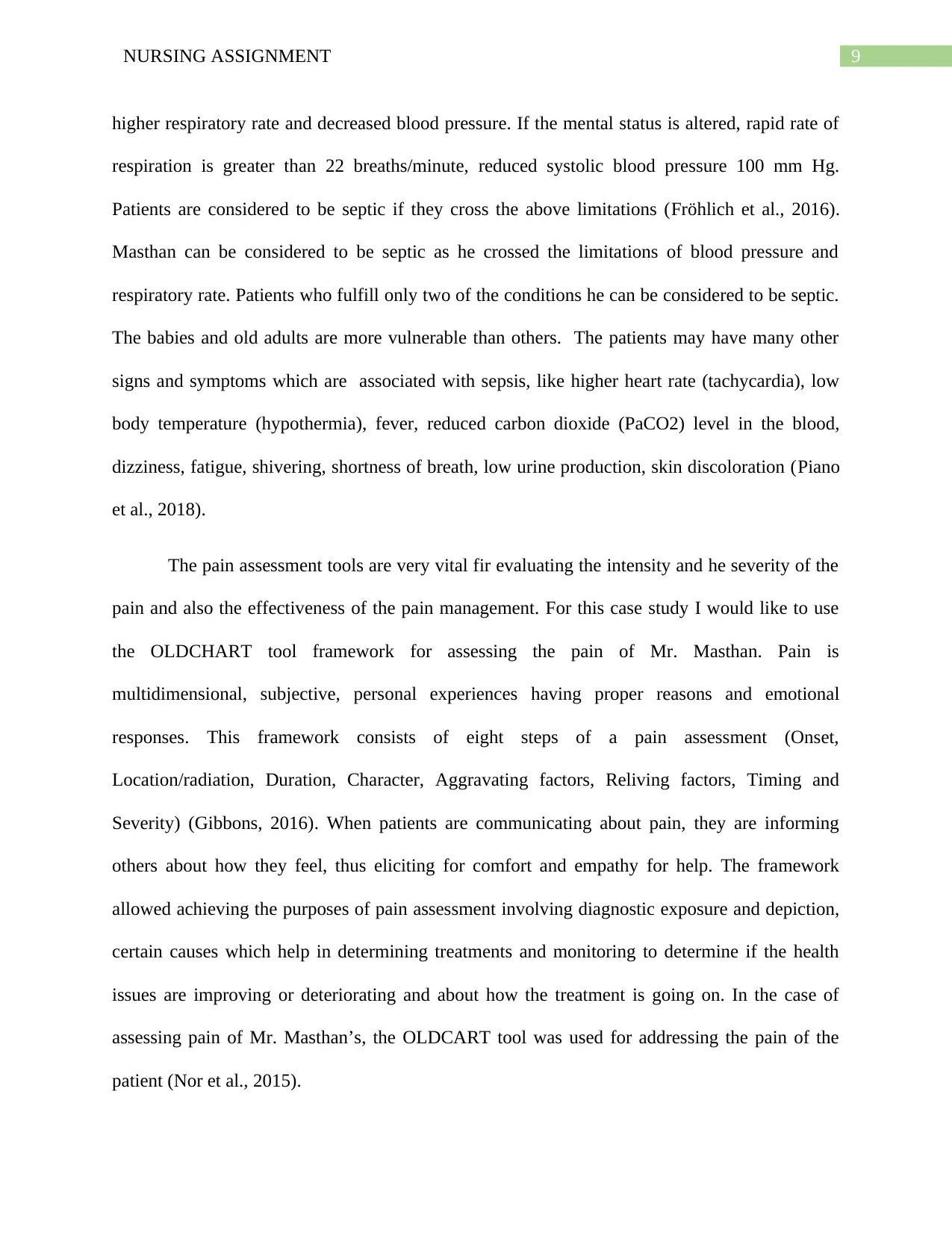
9NURSING ASSIGNMENT
higher respiratory rate and decreased blood pressure. If the mental status is altered, rapid rate of
respiration is greater than 22 breaths/minute, reduced systolic blood pressure 100 mm Hg.
Patients are considered to be septic if they cross the above limitations (Fröhlich et al., 2016).
Masthan can be considered to be septic as he crossed the limitations of blood pressure and
respiratory rate. Patients who fulfill only two of the conditions he can be considered to be septic.
The babies and old adults are more vulnerable than others. The patients may have many other
signs and symptoms which are associated with sepsis, like higher heart rate (tachycardia), low
body temperature (hypothermia), fever, reduced carbon dioxide (PaCO2) level in the blood,
dizziness, fatigue, shivering, shortness of breath, low urine production, skin discoloration (Piano
et al., 2018).
The pain assessment tools are very vital fir evaluating the intensity and he severity of the
pain and also the effectiveness of the pain management. For this case study I would like to use
the OLDCHART tool framework for assessing the pain of Mr. Masthan. Pain is
multidimensional, subjective, personal experiences having proper reasons and emotional
responses. This framework consists of eight steps of a pain assessment (Onset,
Location/radiation, Duration, Character, Aggravating factors, Reliving factors, Timing and
Severity) (Gibbons, 2016). When patients are communicating about pain, they are informing
others about how they feel, thus eliciting for comfort and empathy for help. The framework
allowed achieving the purposes of pain assessment involving diagnostic exposure and depiction,
certain causes which help in determining treatments and monitoring to determine if the health
issues are improving or deteriorating and about how the treatment is going on. In the case of
assessing pain of Mr. Masthan’s, the OLDCART tool was used for addressing the pain of the
patient (Nor et al., 2015).
higher respiratory rate and decreased blood pressure. If the mental status is altered, rapid rate of
respiration is greater than 22 breaths/minute, reduced systolic blood pressure 100 mm Hg.
Patients are considered to be septic if they cross the above limitations (Fröhlich et al., 2016).
Masthan can be considered to be septic as he crossed the limitations of blood pressure and
respiratory rate. Patients who fulfill only two of the conditions he can be considered to be septic.
The babies and old adults are more vulnerable than others. The patients may have many other
signs and symptoms which are associated with sepsis, like higher heart rate (tachycardia), low
body temperature (hypothermia), fever, reduced carbon dioxide (PaCO2) level in the blood,
dizziness, fatigue, shivering, shortness of breath, low urine production, skin discoloration (Piano
et al., 2018).
The pain assessment tools are very vital fir evaluating the intensity and he severity of the
pain and also the effectiveness of the pain management. For this case study I would like to use
the OLDCHART tool framework for assessing the pain of Mr. Masthan. Pain is
multidimensional, subjective, personal experiences having proper reasons and emotional
responses. This framework consists of eight steps of a pain assessment (Onset,
Location/radiation, Duration, Character, Aggravating factors, Reliving factors, Timing and
Severity) (Gibbons, 2016). When patients are communicating about pain, they are informing
others about how they feel, thus eliciting for comfort and empathy for help. The framework
allowed achieving the purposes of pain assessment involving diagnostic exposure and depiction,
certain causes which help in determining treatments and monitoring to determine if the health
issues are improving or deteriorating and about how the treatment is going on. In the case of
assessing pain of Mr. Masthan’s, the OLDCART tool was used for addressing the pain of the
patient (Nor et al., 2015).
Paraphrase This Document
Need a fresh take? Get an instant paraphrase of this document with our AI Paraphraser
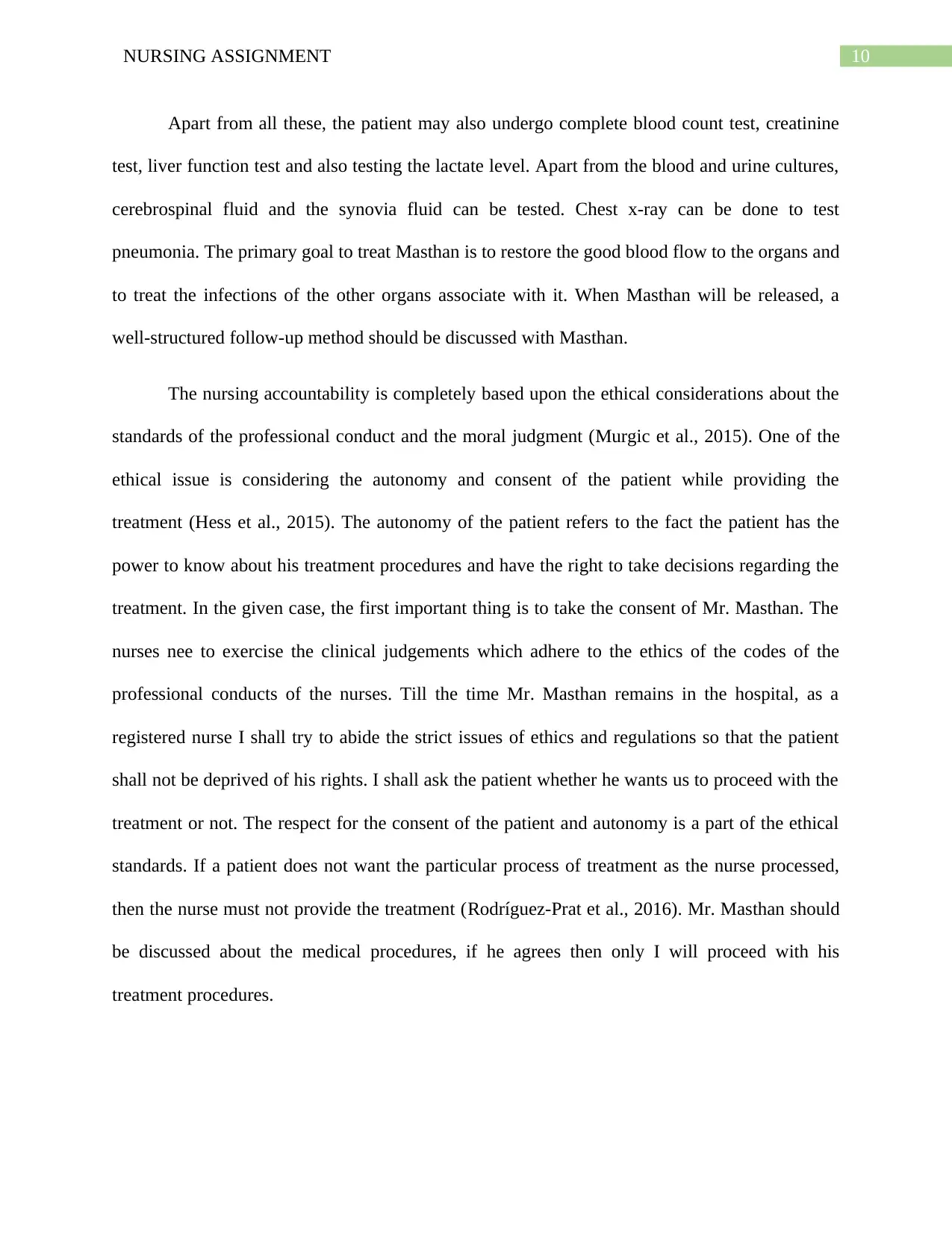
10NURSING ASSIGNMENT
Apart from all these, the patient may also undergo complete blood count test, creatinine
test, liver function test and also testing the lactate level. Apart from the blood and urine cultures,
cerebrospinal fluid and the synovia fluid can be tested. Chest x-ray can be done to test
pneumonia. The primary goal to treat Masthan is to restore the good blood flow to the organs and
to treat the infections of the other organs associate with it. When Masthan will be released, a
well-structured follow-up method should be discussed with Masthan.
The nursing accountability is completely based upon the ethical considerations about the
standards of the professional conduct and the moral judgment (Murgic et al., 2015). One of the
ethical issue is considering the autonomy and consent of the patient while providing the
treatment (Hess et al., 2015). The autonomy of the patient refers to the fact the patient has the
power to know about his treatment procedures and have the right to take decisions regarding the
treatment. In the given case, the first important thing is to take the consent of Mr. Masthan. The
nurses nee to exercise the clinical judgements which adhere to the ethics of the codes of the
professional conducts of the nurses. Till the time Mr. Masthan remains in the hospital, as a
registered nurse I shall try to abide the strict issues of ethics and regulations so that the patient
shall not be deprived of his rights. I shall ask the patient whether he wants us to proceed with the
treatment or not. The respect for the consent of the patient and autonomy is a part of the ethical
standards. If a patient does not want the particular process of treatment as the nurse processed,
then the nurse must not provide the treatment (Rodríguez-Prat et al., 2016). Mr. Masthan should
be discussed about the medical procedures, if he agrees then only I will proceed with his
treatment procedures.
Apart from all these, the patient may also undergo complete blood count test, creatinine
test, liver function test and also testing the lactate level. Apart from the blood and urine cultures,
cerebrospinal fluid and the synovia fluid can be tested. Chest x-ray can be done to test
pneumonia. The primary goal to treat Masthan is to restore the good blood flow to the organs and
to treat the infections of the other organs associate with it. When Masthan will be released, a
well-structured follow-up method should be discussed with Masthan.
The nursing accountability is completely based upon the ethical considerations about the
standards of the professional conduct and the moral judgment (Murgic et al., 2015). One of the
ethical issue is considering the autonomy and consent of the patient while providing the
treatment (Hess et al., 2015). The autonomy of the patient refers to the fact the patient has the
power to know about his treatment procedures and have the right to take decisions regarding the
treatment. In the given case, the first important thing is to take the consent of Mr. Masthan. The
nurses nee to exercise the clinical judgements which adhere to the ethics of the codes of the
professional conducts of the nurses. Till the time Mr. Masthan remains in the hospital, as a
registered nurse I shall try to abide the strict issues of ethics and regulations so that the patient
shall not be deprived of his rights. I shall ask the patient whether he wants us to proceed with the
treatment or not. The respect for the consent of the patient and autonomy is a part of the ethical
standards. If a patient does not want the particular process of treatment as the nurse processed,
then the nurse must not provide the treatment (Rodríguez-Prat et al., 2016). Mr. Masthan should
be discussed about the medical procedures, if he agrees then only I will proceed with his
treatment procedures.
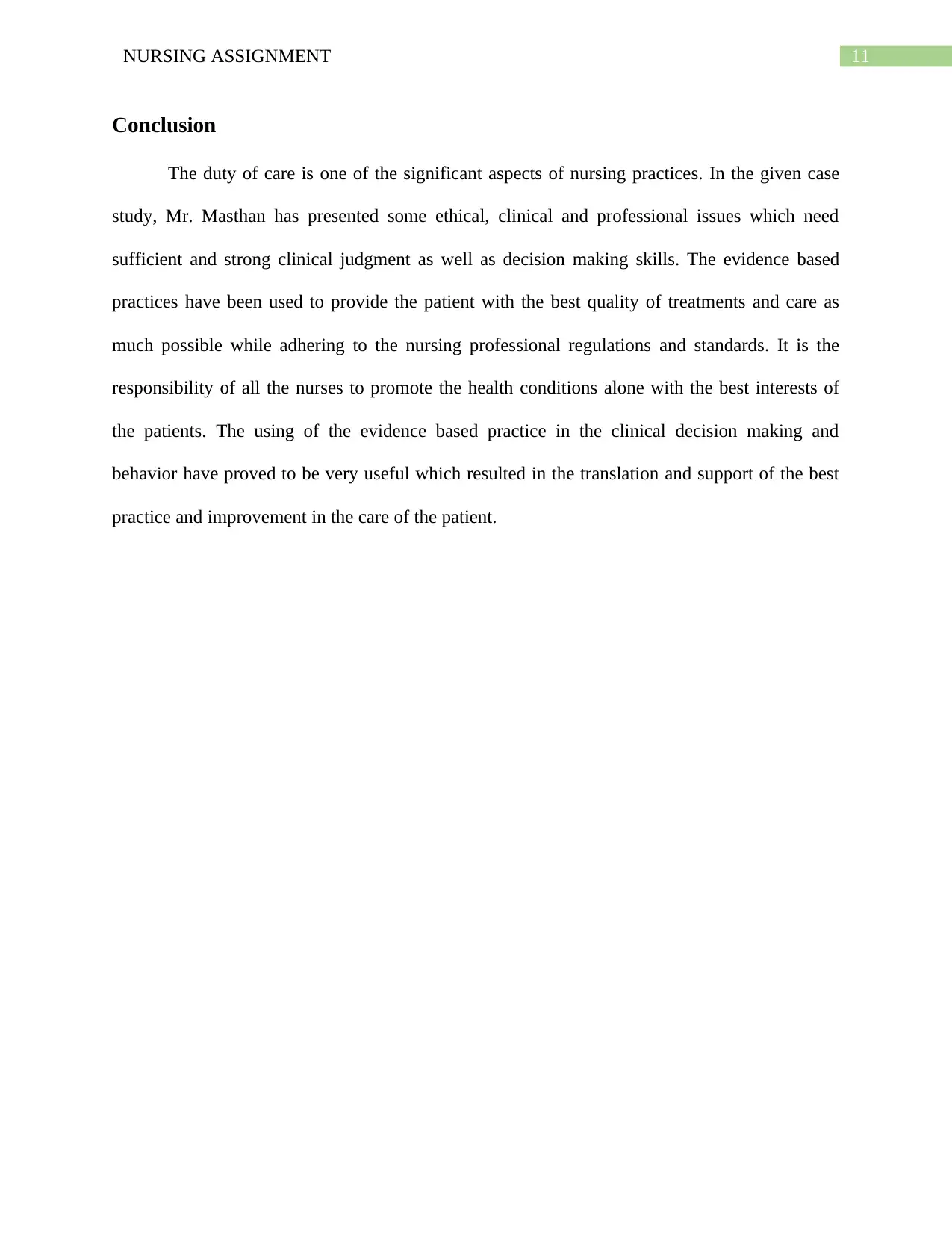
11NURSING ASSIGNMENT
Conclusion
The duty of care is one of the significant aspects of nursing practices. In the given case
study, Mr. Masthan has presented some ethical, clinical and professional issues which need
sufficient and strong clinical judgment as well as decision making skills. The evidence based
practices have been used to provide the patient with the best quality of treatments and care as
much possible while adhering to the nursing professional regulations and standards. It is the
responsibility of all the nurses to promote the health conditions alone with the best interests of
the patients. The using of the evidence based practice in the clinical decision making and
behavior have proved to be very useful which resulted in the translation and support of the best
practice and improvement in the care of the patient.
Conclusion
The duty of care is one of the significant aspects of nursing practices. In the given case
study, Mr. Masthan has presented some ethical, clinical and professional issues which need
sufficient and strong clinical judgment as well as decision making skills. The evidence based
practices have been used to provide the patient with the best quality of treatments and care as
much possible while adhering to the nursing professional regulations and standards. It is the
responsibility of all the nurses to promote the health conditions alone with the best interests of
the patients. The using of the evidence based practice in the clinical decision making and
behavior have proved to be very useful which resulted in the translation and support of the best
practice and improvement in the care of the patient.
⊘ This is a preview!⊘
Do you want full access?
Subscribe today to unlock all pages.

Trusted by 1+ million students worldwide
1 out of 16
Related Documents
Your All-in-One AI-Powered Toolkit for Academic Success.
+13062052269
info@desklib.com
Available 24*7 on WhatsApp / Email
![[object Object]](/_next/static/media/star-bottom.7253800d.svg)
Unlock your academic potential
Copyright © 2020–2025 A2Z Services. All Rights Reserved. Developed and managed by ZUCOL.





